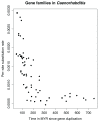BioHackathon 2015: Semantics of data for life sciences and reproducible research
- PMID: 32308977
- PMCID: PMC7141167
- DOI: 10.12688/f1000research.18236.1
BioHackathon 2015: Semantics of data for life sciences and reproducible research
Abstract
We report on the activities of the 2015 edition of the BioHackathon, an annual event that brings together researchers and developers from around the world to develop tools and technologies that promote the reusability of biological data. We discuss issues surrounding the representation, publication, integration, mining and reuse of biological data and metadata across a wide range of biomedical data types of relevance for the life sciences, including chemistry, genotypes and phenotypes, orthology and phylogeny, proteomics, genomics, glycomics, and metabolomics. We describe our progress to address ongoing challenges to the reusability and reproducibility of research results, and identify outstanding issues that continue to impede the progress of bioinformatics research. We share our perspective on the state of the art, continued challenges, and goals for future research and development for the life sciences Semantic Web.
Keywords: BioHackathon; Bioinformatics; Databases; Linked Open Data; Metadata; Ontology; Semantic Web; Visualization; Web Services; Workflows.
Copyright: © 2020 Vos RA et al.
Conflict of interest statement
No competing interests were disclosed.
Figures






Similar articles
-
The 3rd DBCLS BioHackathon: improving life science data integration with Semantic Web technologies.J Biomed Semantics. 2013 Feb 11;4(1):6. doi: 10.1186/2041-1480-4-6. J Biomed Semantics. 2013. PMID: 23398680 Free PMC article.
-
BioHackathon series in 2011 and 2012: penetration of ontology and linked data in life science domains.J Biomed Semantics. 2014 Feb 5;5(1):5. doi: 10.1186/2041-1480-5-5. J Biomed Semantics. 2014. PMID: 24495517 Free PMC article.
-
The DBCLS BioHackathon: standardization and interoperability for bioinformatics web services and workflows. The DBCLS BioHackathon Consortium*.J Biomed Semantics. 2010 Aug 21;1(1):8. doi: 10.1186/2041-1480-1-8. J Biomed Semantics. 2010. PMID: 20727200 Free PMC article.
-
Semantic Web technologies for the big data in life sciences.Biosci Trends. 2014 Aug;8(4):192-201. doi: 10.5582/bst.2014.01048. Biosci Trends. 2014. PMID: 25224624 Review.
-
The emergence of Semantic Systems Biology.N Biotechnol. 2013 Mar 25;30(3):286-90. doi: 10.1016/j.nbt.2012.11.008. Epub 2012 Nov 16. N Biotechnol. 2013. PMID: 23165099 Review.
Cited by
-
Why and how to engage expert stakeholders in ontology development: insights from social and behavioural sciences.J Biomed Semantics. 2021 Mar 23;12(1):4. doi: 10.1186/s13326-021-00240-6. J Biomed Semantics. 2021. PMID: 33757593 Free PMC article. Review.
-
Choosing preferable labels for the Japanese translation of the Human Phenotype Ontology.Genomics Inform. 2020 Jun;18(2):e23. doi: 10.5808/GI.2020.18.2.e23. Epub 2020 Jun 18. Genomics Inform. 2020. PMID: 32634877 Free PMC article.
-
A Simple Standard for Sharing Ontological Mappings (SSSOM).Database (Oxford). 2022 May 25;2022:baac035. doi: 10.1093/database/baac035. Database (Oxford). 2022. PMID: 35616100 Free PMC article.
References
-
- Triple Pattern Fragments. [cited 2018 May 8]. Reference Source

